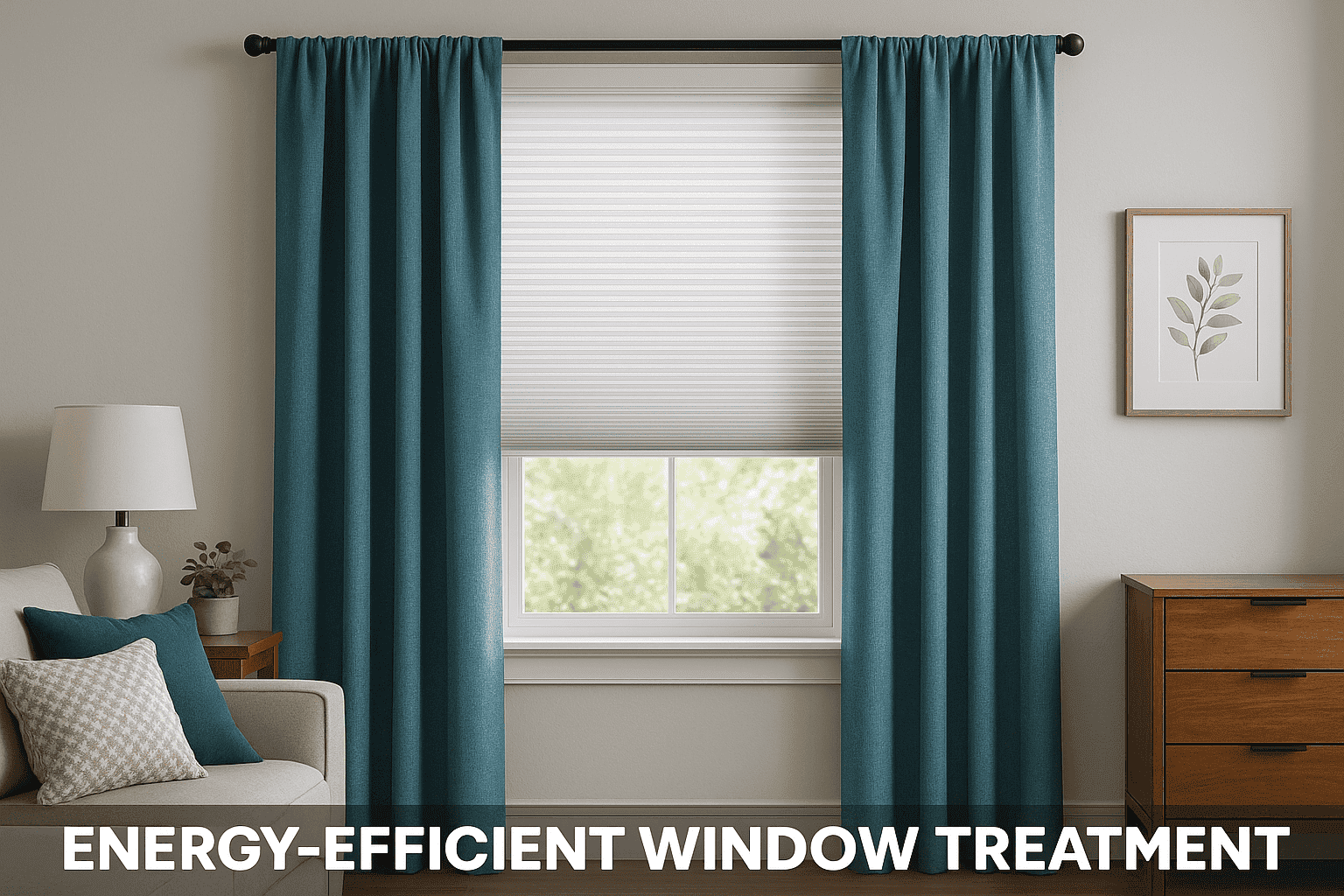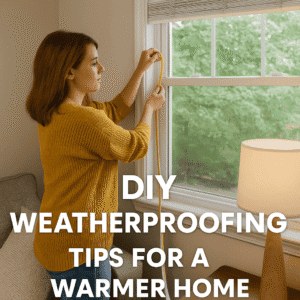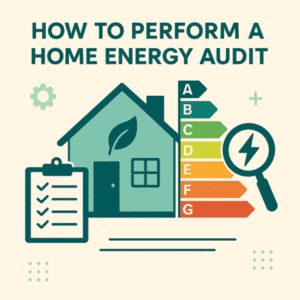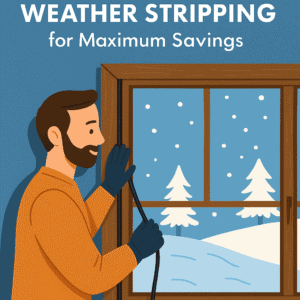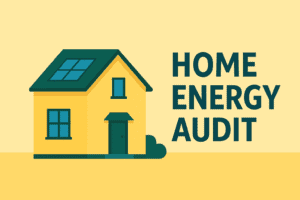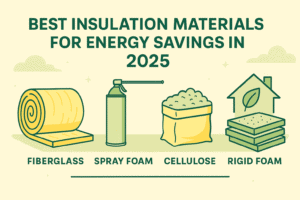Energy Efficient Window Treatments: Best Options for 2025
Windows play a critical role in your home’s energy performance. According to the U.S. Department of Energy, up to 30% of heating and cooling energy is lost through windows and doors, making energy efficient window treatments one of the most effective yet low-cost insulation upgrades.
In this 2025 guide, we’ll explore the best options available, explain how they work, show real-world savings, and help you choose based on your climate, budget, and aesthetics.
You’ll learn:
- How window treatments improve insulation and reduce heating/cooling loss
- The top energy efficient window treatments on the market
- Side-by-side pros & cons of each option
- Installation and selection tips for DIY efficiency
- How to combine treatments with thermostats, smart plugs, and insulation for maximum savings
- Where to buy, approximate prices, and energy savings estimates
- Expert tips to maintain performance year-round
Key related guides:
- DIY insulation: Best Insulation Materials for Energy Savings
- Draft blocking: How to Install Weather Stripping
- Smart appliances: Home Energy Audit Checklist
Let’s unlock the potential of your windows and boost your comfort and savings using energy efficient window treatments optimized for 2025.
How Window Treatments Save Energy
Energy efficient window treatments conserve energy through two main strategies:
- Reducing Heat Transfer
- In winter, they trap air to slow heat escape
- In summer, they reflect or absorb solar heat
- Blocking Radiation & Drafts
- Reflective shades reduce solar heat gain
- Insulated curtains buffer temperature swings and block drafts
Below is a comparison of R-values (heat resistance):
| Treatment Type | Approx R-Value |
|---|---|
| Single pane window | R-1 |
| Double-pane window | R-2 to R-3 |
| Cellular shade (2” cells) | R-3 to R-5 |
| Thermal blackout curtains | R-3 |
| Exterior roll-down shade | R-8 to R-10 |
Studies show that pairing double-pane windows with cellular shades can reduce heating losses by 25–40% and cooling loads by 10–25%.
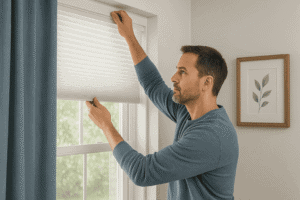
Top 6 Energy‑Efficient Window Treatments for 2025
We’ve evaluated performance, aesthetics, installation, and affordability. Here are the top options:
1. Cellular (Honeycomb) Shades
How they work: Air pockets (“cells”) trap air, insulating your window and reducing both heat loss in winter and heat gain in summer.
Popular brands:
- Hunter Douglas Duette (top-tier performance)
- AlbaPremier by Select Blinds (great value)
Pros:
- Excellent R‑value (R‑3–R‑5 for double-cell)
- Sleek design; wide fabric/color options
- Motorized, cordless, blackout models
- Customizable honeycomb size
Cons:
- Higher upfront cost ($70–300 per shade)
- Cleaning can be tricky
- Heat buildup risk with dark interior color
This is my go-to energy efficient window treatment for year-round comfort.
2. Thermal & Blackout Curtains
How they work: Heavy fabrics and light-blocking liners trap heat and block drafts.
Popular brands:
Pros:
- Affordable ($20–70 per panel)
- Easy DIY rod installation
- Large style/color range
- Alone or layered over blinds
Cons:
- Less insulating than cellular shades
- Needs precise length for draft blocking
- Regular cleaning required
Lower cost DIY upgrade ideal for renters or DIY enthusiasts.
3. Roller Shades with Reflective Coatings
How they work: Reflective surfaces deflect solar radiation before it enters your home.
Brands:
Pros:
- Prevents solar gain (especially south/west)
- Low profile; motorization available
- Budget range from $30 to $250+
Cons:
- Aesthetic limited to screen style
- Offers modest insulation indoors
- Requires precise measurement
Best for summer-heavy climates or west-facing windows.
4. Insulated Cellular Roman Shades
How they work: Blend the insulating properties of honeycomb shades with the elegance of fabric roman shades.
Brand Spotlight:
- Graber RomanShield Insulated Roman Shade
Pros:
- R-value ~2–3
- Adds soft décor elegance
- Custom colors and motors
Cons:
- Expensive ($200–400)
- Higher maintenance for fabric folds
- Bulkier than basic roller shades
High-end, cozy, and efficient for living spaces and bedrooms.
5. Exterior Roller/Shutter Shades
How they work: Installed outside to block radiant heat before it enters.
Brands:
- Somfy Outdoor Roller Shutters
- Allen + Roth Solar-Block Exterior Roller Shade
Pros:
- Best insulation (exterior window R-value can double)
- Enhances security and sound dampening
- Automated motor systems
Cons:
- Pro installation ($200+ per window)
- May require permits
- Generates outdoor heat on façade
Ideal for full home efficiency upgrades and solar homes.
6. Window Film
How it works: Adhesive or static-cling films reflect infrared heat or UV light.
Popular films:
Pros:
- Very affordable ($5–15 per window)
- Blocks UV and glare
- Can be DIY installed
Cons:
- No extra insulation layer
- Optical distortion risk if poorly installed
- Long-term durability questionable
Great starter treatment or supplementary to other options.
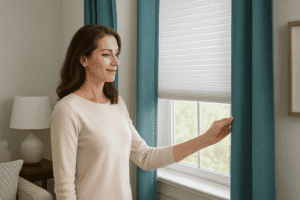
Comparing Window Treatments Side by Side
| Treatment Type | R-Value | Cost/Window | Best For | Install Time |
|---|---|---|---|---|
| Cellular Shades (double-cell) | R-3 to R-5 | $150–300 | Year-round insulation, bedrooms | 30–60 min |
| Thermal/Blackout Curtains | R-1 to R-3 | $40–120 | Drafty rooms, renters, easy installs | Fast (rod install) |
| Reflective Roller Shades | R-1 to R-2 | $30–250 | Hot sunlight rooms, patios | 20–40 min |
| Insulated Roman Shades | R-2 to R-3 | $200–400 | Living rooms, upscale interiors | 45–60 min |
| Exterior Roller/Shutter Shades | R-2 to R-10 | $300–800 | Full-home upgrades, passive homes | Pro install |
| Window Film | R-0.5 to R-1 | $5–30 | Budget, basement windows, overlays | 15–30 min |
Choosing the Best Treatment for Your Needs
To choose the best energy efficient window treatments, factor in:
- Climate Zone:
- Cold zones? Go for cellular or insulated curtains
- Hot climates? Reflective or exterior shades essential
- Window Facing:
- South/West: Prioritize solar heat blocking
- North/East: Draft prevention more important
- Style & Budget
- Tight budget: curtains or film
- Mid-range: cellular or roller shades
- Luxury: insulated romans or motorized exterior shades
- DIY or Professional
- Curtains/film: simple to install
- Cellular shades: mid-difficulty level
- Exterior systems: professional installation needed
- Smart Integration
- Motorized shades can sync with smart thermostats, blinds, motion sensors, and routines
Installation & DIY Tips
Here’s how to get the most from your energy efficient window treatments:
- Accurate Measurements: Width + height; note inside/outside mount preferences
- Mounting Advice: Tight fits reduce drafts
- Layer for Effect: Combine curtains over shades for added insulation
- Ensure Light Blocking: Sealing at edges helps reduce leakage
- Remote and Sensor Setup: Automate with smart hubs and thermostats
- Regular Maintenance: Dust cells weekly; vacuum curtains as needed
- Seasonal Use: Open winter daytime, close summer nights and daytime
- Cost vs ROI:
- Example: $250 cellular shade = $30–50/year savings → 5-year payback
- Exterior shades $600 installed → $80/year savings → ~7-year payback
- Rebates: ENERGY STAR® cellular shades or roller screens may qualify
Cost, Value & ROI by Treatment
Detailed estimates:
| Treatment | Cost/window | Savings/year | Payback (years) |
|---|---|---|---|
| Double-cell Cellular Shades | $180 | $35 | 5.2 |
| Thermal Blackout Curtains (Qty 2) | $100 | $20 | 5.0 |
| Reflective Roller Shades | $120 | $30 | 4.0 |
| Insulated Roman Shades | $300 | $45 | 6.7 |
| Exterior Roller/Shutter Shades | $600 | $80 | 7.5 |
| Window Film (Sheet-pack) | $20 | $10 | 2.0 |
Use these numbers to plan your upgrades and prioritize based on window orientation and budget. Highest ROI: double-cell shades and roller screens.
Smart Integration & Automation
Pair window treatments with thermostats, smart sensors, and plugs:
- Sync roller shades with temperature sensors
- Automate curtains: open at sunrise/winter, close midday/summer
- Voice commands: “Alexa, goodnight” triggers curtains/shades
- Save energy with routines instead of HVAC: shading + smart thermostat = 5–15% extra savings
Combine energy efficient window treatments with smart upgrades like smart plugs, thermostats, and ceiling fans to create a cohesive energy-saving strategy.
Maintenance Tips
- Clean dust weekly
- Check for fabric fading or heat damage
- Replace puckered or sagging shades
- Inspect weather seals and realign edge straps
- Update software on motorized systems
A little upkeep extends lifespan and efficiency.
Final Thoughts
Investing in energy efficient window treatments in 2025 is not just a cosmetic decision, it’s a strategic upgrade that pays off in multiple ways. These smart window solutions enhance comfort, reduce energy bills, and increase privacy, all while contributing to a more sustainable home. Whether you’re dealing with cold winters, scorching summers, or simply looking to reduce your household’s carbon footprint, energy-efficient window treatments are one of the smartest and most accessible insulation choices available today.
Unlike expensive HVAC overhauls or full window replacements, the right window treatments offer a cost-effective alternative that’s easy to install, highly customizable, and delivers year-round performance. From cellular shades that trap heat in their honeycomb design to thermal curtains that block out drafts and sun, and reflective window films that reject UV rays, there’s something for every room, climate, and budget.
The real beauty of energy efficient window treatments lies in their versatility. You can pair them with other upgrades, like smart thermostats, weather stripping, or energy saving smart plugs to create a layered defense against energy loss. When combined strategically, these systems drastically reduce HVAC loads and help maintain indoor temperatures with minimal effort.
Moreover, modern options come in attractive styles and colors, so there’s no need to compromise aesthetics for performance. Whether you prefer sleek roller shades, classic Roman blinds, or tech-savvy motorized treatments, today’s market offers products that blend form with function seamlessly.
Don’t overlook exterior treatments either. Outdoor solar shades, awnings, and shutters can dramatically reduce solar heat gain before it even reaches the glass. These treatments are especially helpful for large, sun-exposed windows and are an excellent addition for homes in hotter climates.
Keep in mind that your energy savings will depend not just on the type of treatment you choose, but also on how you use them. Automated systems or scheduled manual adjustments (such as closing blinds during peak sun hours) can make a noticeable impact on monthly utility bills.
If you’re serious about cutting your energy costs and improving year-round comfort, energy efficient window treatments should be a top priority. They work quietly in the background, insulating your home, reducing glare, protecting furnishings, and minimizing your reliance on artificial heating and cooling.
By integrating the right window solutions into your home energy strategy, you’re not just making a minor upgrade, you’re embracing a smarter, greener lifestyle. And in 2025, when sustainability, comfort, and savings matter more than ever, that’s a win-win decision worth making.
Make energy efficient window treatments a part of your insulation plan today, and enjoy the rewards for years to come.
Also Read on TheWattAdvisor related to Energy Efficient Window Treatments
- How to Install Weather Stripping
- Best Insulation Materials
- DIY Home Energy Audit Checklist
- Solar Shades & Roof Comparison
FAQs
What are the most energy‑efficient window treatments?
Cellular (honeycomb) shades and exterior roller or shutter shades offer the best overall energy efficiency due to their insulation and heat-blocking properties. Thermal curtains and reflective roller shades also perform very well, especially in specific climates.
How much can window treatments reduce energy bills?
Properly installed energy-efficient window treatments can cut heating bills up to 30% in winter and reduce cooling energy use by 10‑25% in summer, depending on your climate, window orientation, and usage patterns.
Can I install these treatments myself?
Yes—most interior treatments like cellular shades, roller shades, and curtains are easy for DIY installation. Exterior shades and motorized systems may require professional assistance.
Do energy-efficient window treatments qualify for rebates?
Yes, certain ENERGY STAR-rated cellular shades and exterior solar screens may qualify for utility rebates in 2025. Check your local program or use the DSIRE database to confirm eligibility.
This post was on Energy Efficient Window Treatments: Best Options for 2025

